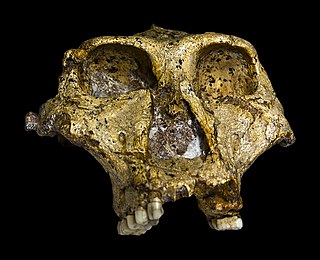
Paranthropus is a genus of extinct hominin which contains two widely accepted species: P. robustus and P. boisei. However, the validity of Paranthropus is contested, and it is sometimes considered to be synonymous with Australopithecus. They are also referred to as the robust australopithecines. They lived between approximately 2.6 and 0.6 million years ago (mya) from the end of the Pliocene to the Middle Pleistocene.
Wallaroo is a common name for several species of moderately large macropods, intermediate in size between the kangaroos and the wallabies. The word "wallaroo" is from the Dharug walaru. In general, a large, slim-bodied macropod of the open plains is called a "kangaroo"; a small to medium-sized one, particularly if it is relatively thick-set, is a "wallaby". Most wallaroos are only a little smaller than a kangaroo and a little bigger than a wallaby, fairly thick-set, and are found in open country. All share a particular habit of stance: wrists raised, elbows tucked close into the body, and shoulders thrown back, and all have a large, black-skinned rhinarium.

Paranthropus robustus is a species of robust australopithecine from the Early and possibly Middle Pleistocene of the Cradle of Humankind, South Africa, about 2 to 1 or 0.6 million years ago. It has been identified in Kromdraai, Swartkrans, Sterkfontein, Gondolin, Cooper's, and Drimolen Caves. Discovered in 1938, it was among the first early hominins described, and became the type species for the genus Paranthropus. However, it has been argued by some that Paranthropus is an invalid grouping and synonymous with Australopithecus, so the species is also often classified as Australopithecus robustus.

The common wallaroo, also known as the euro, hill wallaroo, or simply wallaroo is a species of macropod. The word euro is particularly applied to one subspecies.
Sinocyclocheilus is a genus of freshwater fish in the family Cyprinidae endemic to China, where only found in Guangxi, Guizhou and Yunnan. Almost all of its species live in or around caves and most of these have adaptions typical of cavefish such as a lack of scales, lack of pigmentation and reduced eyes. Several species have an unusual hunchbacked appearance and some of the cave-dwellers have a "horn" on the back, the function of which is unclear. In contrast, the Sinocyclocheilus species that live aboveground, as well as a few found underground, show no clear cavefish adaptions. They are relatively small fish reaching up to 23 cm (9.1 in) in length. The individual species have small ranges and populations, leading to the status of most of the evaluated species as threatened. Many species populations in the genus have yet to be evaluated by the IUCN.
The duck-billed golden-line fish is a species of cyprinid. It is found only in China.
The gold-colored angle fish is a species of cyprinid fish.

Voay is an extinct genus of crocodile from Madagascar and includes only one species—V. robustus. Numerous subfossils have been found, including complete skulls as well as vertebrae and osteoderms from such places as Ambolisatra and Antsirabe. The genus is thought to have become extinct relatively recently during the Holocene. It has even been suggested to have disappeared in the extinction event that wiped out much of the endemic megafauna such as the elephant bird following the arrival of humans to Madagascar around 2000 years ago. Its name comes from the Malagasy word for crocodile.

Tian'e is a county of northwestern Guangxi, China, located on the upper reaches of the Hongshui River and bordering Guizhou province to the northwest. It is under the administration of the prefecture-level city of Hechi.

Donglan County is a county of northwest Guangxi, China. It is under the administration of Hechi City.
Sinocyclocheilus angustiporus is a species of ray-finned fish in the genus Sinocyclocheilus.
Sinocyclocheilus guilinensis is a species of ray-finned fish in the genus Sinocyclocheilus.
Sinocyclocheilus macrolepis is a species of ray-finned fish in the genus Sinocyclocheilus.
Sinocyclocheilus macroscalus is a species of ray-finned fish in the genus Sinocyclocheilus.
Sinocyclocheilus rhinocerous is a species of ray-finned fish in the genus Sinocyclocheilus.
Sinocyclocheilus tileihornes is a species of freshwater ray-finned fish in the genus Sinocyclocheilus. It is indigenous to Asia and, like most fish of the Sinocyclocheilus genus, lives primarily in or around caves.
Sinocyclocheilus tingi is a species of freshwater fish in the family Cyprinidae. It is only known from Fuxian Lake in Yunnan. It grows to 18.3 cm (7.2 in) SL.
Sinocyclocheilus wumengshanensis is a species of ray-finned fish in the genus Sinocyclocheilus.
S. robustus may refer to:
Sinocyclocheilus jinxiensis is a species of cavefish in the family Cyprinidae endemic to Xiaolong Spring in Jinxi County, Guangxi, China. In 2016, it was proposed that this species should be moved to its own genus Pseudosinocyclocheilus.




